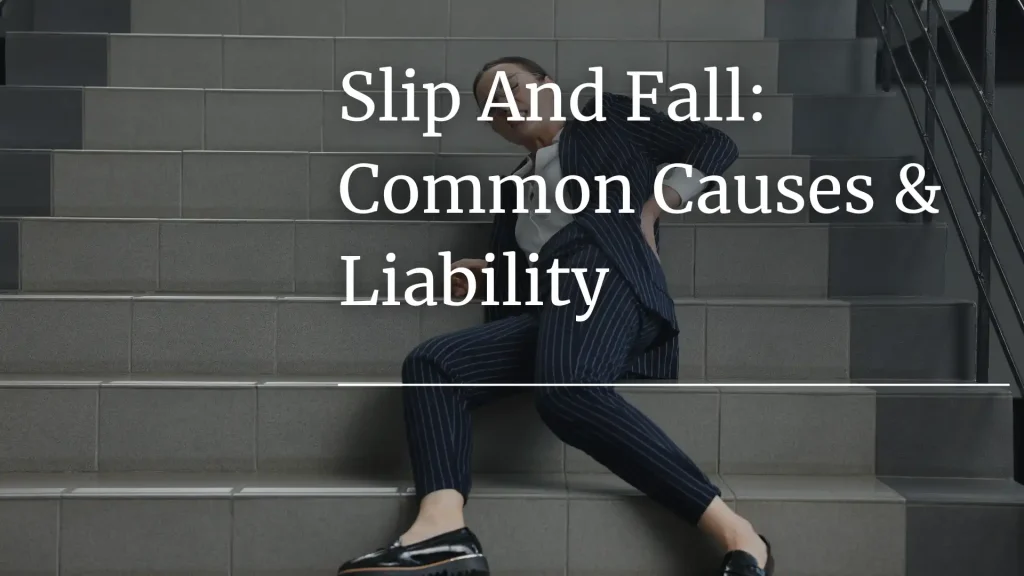Posted on Monday, June 10th, 2024 at 8:14 pm

If you were injured in a slip-and-fall accident on someone else’s property, you may have a valid personal injury claim against them. Premises liability laws hold property owners and managers accountable for hazards on their property that cause harm.
Slip-and-fall injuries can be severe and long-lasting, so filing a personal injury claim to seek compensation is crucial. The last thing you want after being injured due to someone else’s negligence is to be left financially responsible for your medical costs, lost income, and more.
Common Causes of Slip-and-Fall Injuries
Most slip-and-fall injuries in Chicago result from a few common scenarios, including:
- Wet surfaces, such as puddles in supermarket aisles
- Uneven surfaces, such as restaurants that have a single step up into the dining area
- Uncleared snow and ice on sidewalks and parking lots
- Damaged stairwells with uneven steps or unsecured railings
Slip-and-Fall Liability
Who is responsible for your injuries after you’ve slipped and fallen? There are a few parties who could be liable depending on the specific circumstances of your case. An experienced premises liability attorney can assist you in determining the proper party (or parties) to bring your claim against.
The first option is the owner of the property. Property owners are responsible for ensuring their properties are safe and free from hazards to visitors. In some cases, the property owner may be partially liable even if another party is liable for your injuries.
A second option is the property manager. If the property owner serves as a landlord, they may not be responsible for the day-to-day operation and maintenance of the property. In this case, you may be able to bring a claim against the business that operates out of the property or the person who rents the property.
It is also possible that a third party is responsible for the maintenance of the property and that their inadequate maintenance led to your injuries. A business might hire a snow removal company to keep their parking lot free from snow and ice, for example. A landscaping company may also be responsible for maintaining the grounds.
There doesn’t need to be only one party liable for your injuries. If multiple parties share fault, it may make it easier for you to collect the total amount of compensation you’re seeking. If your awarded compensation exceeds the insurance limits of one party, it may not exceed the insurance limits of two or more when split between them.
Proving Negligence in Slip-and-Fall Cases
To prove negligence in your case, you’ll need to demonstrate that the property owner (or other liable party) either knew or should have known about the hazard on the property. There are two main ways to do this:
- You can show that the hazard was present on the property long enough for the owner to know about it.
- You can show that the hazard was a regular occurrence and that it was easy to foresee that it would happen again.
A loose railing for months before your slip and fall may be a hazard present for long enough that the property owner should have fixed it, for example. Also, a refrigerator in a supermarket aisle that frequently leaks may be a regularly occurring hazard that the property owner should fix or preemptively check for puddles.
To prove these things, you’re going to need evidence. That’s where your attorney comes in. Attorneys are experts at gathering evidence supporting their clients’ claims, including:
- Security camera footage that shows your slip and fall
- Eyewitness statements
- Expert witness testimony
- Photographs of your injuries and the hazard that caused them
- Medical records detailing your treatments
- Financial records proving your lost income
The Legal Process for Slip-and-Fall Claims

After you’ve undergone your initial medical treatment for your injuries, the next step is to speak to an attorney so they can begin working on your claim. Your attorney will review your case and gather the above evidence to support it.
Once your attorney has had a chance to collect evidence, they’ll provide a valuation for your claim. This will be the amount of money, based on your past and future medical expenses, lost wages, and more, that you are seeking through your claim.
The next step is to file your claim. Illinois’s statute of limitations for a personal injury claim is two years. Your attorney will file your claim correctly and within this time limit.
The discovery phase comes after the at-fault party receives notice of your claim. This phase is when both sides exchange evidence to avoid surprises at trial. At this point, your attorney may get a statement from the property owner or any other liable parties.
Now that both sides know all the evidence each other has, it’s time to enter settlement negotiations. During negotiations, your attorney will attempt to get the at-fault party to agree to a fair compensation amount. Most lawsuits end at this phase. If you can’t settle, however, your case will proceed to trial.
At trial, your attorney will present the entire case they’ve built against the at-fault party before a jury. This involves assembling all the evidence they gathered earlier to form a cohesive argument.
If the jury decides the case in your favor, the only thing left to do is collect your compensation. The at-fault party’s insurance provider may attempt to appeal the verdict. But if that happens, your attorney will continue to fight for your rights.
Chicago, Illinois, Slip-and-Fall Attorney
Did you suffer injuries after slipping and falling on someone else’s property? Contact Wallace Miller online or at (312) 261-6193 for a free consultation about your case with one of our experienced premises liability attorneys.
We’ll evaluate your case, explain your legal options, and answer any questions you have about the personal injury claims process.
